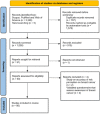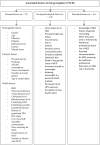Risk perception of non-communicable diseases: A systematic review on its assessment and associated factors
- PMID: 37262079
- PMCID: PMC10234567
- DOI: 10.1371/journal.pone.0286518
Risk perception of non-communicable diseases: A systematic review on its assessment and associated factors
Abstract
Background: The burden of non-communicable diseases (NCDs) is increasing. Risk perception of NCDs is an important factor towards the uptake of preventive health interventions. There are various questionnaires assessing risk perception of NCDs, but no internationally standardized questionnaire has been available. Identification of factors associated with risk perception of NCDs may facilitate the development of targeted interventions. This systematic review aims to identify available questionnaire assessing risk perception of NCDs and the factors associated with risk perception of NCDs.
Methods: The reporting of this systematic review is in accordance with the Preferred Reporting Items for Systematic Reviews and Meta-Analyses guidelines. We carried out a literature search through three databases (Scopus, PubMed, Web of Science) and targeted original article published in English between 2012 and 2021. Quality appraisal of the eligible articles was conducted using the Mixed Methods Appraisal Tool. Findings were synthesized using content analysis.
Results: A total of 86 studies were included. We found a variety of questionnaires assessing risk perception of NCDs, with many differences in their development, domains, items and validity. We also identified several personal, sociopsychological and structural factors associated with risk perception of NCDs.
Limitations: Most of the included studies were of cross-sectional design, and therefore the quality of evidence was considered low and exhibit a high risk of bias. The role of publication bias within this systematic review should be acknowledged as we did not include grey literature. Additionally, language bias must be considered as we only included English-language publications.
Conclusion: Further development and testing of available questionnaire is warranted to ensure their robustness and validity in measuring risk perception of NCDs. All the identified factors deserve further exploration in longitudinal and experimental studies.
Copyright: © 2023 Jane Ling et al. This is an open access article distributed under the terms of the Creative Commons Attribution License, which permits unrestricted use, distribution, and reproduction in any medium, provided the original author and source are credited.
Conflict of interest statement
The authors have declared that no competing interests exist.
Figures
Similar articles
-
The role of illness perception in the physical activity domain of health-promoting lifestyle among patients with non-communicable diseases: A systematic review.PLoS One. 2024 Nov 8;19(11):e0311427. doi: 10.1371/journal.pone.0311427. eCollection 2024. PLoS One. 2024. PMID: 39514466 Free PMC article.
-
Beyond the black stump: rapid reviews of health research issues affecting regional, rural and remote Australia.Med J Aust. 2020 Dec;213 Suppl 11:S3-S32.e1. doi: 10.5694/mja2.50881. Med J Aust. 2020. PMID: 33314144
-
A systematic review on the level of risk perception of diabetes mellitus: The role of environmental factor.PLoS One. 2024 Jul 30;19(7):e0308152. doi: 10.1371/journal.pone.0308152. eCollection 2024. PLoS One. 2024. PMID: 39078862 Free PMC article.
-
Dose-response relationship between physical activity and mortality in people with non-communicable diseases: a study protocol for the systematic review and meta-analysis of cohort studies.BMJ Open. 2019 Sep 11;9(9):e028653. doi: 10.1136/bmjopen-2018-028653. BMJ Open. 2019. PMID: 31511283 Free PMC article.
-
Association between food insecurity and key metabolic risk factors for diet-sensitive non-communicable diseases in sub-Saharan Africa: a systematic review and meta-analysis.Sci Rep. 2021 Mar 4;11(1):5178. doi: 10.1038/s41598-021-84344-0. Sci Rep. 2021. PMID: 33664339 Free PMC article.
Cited by
-
Machine Learning-Based Hyperglycemia Prediction: Enhancing Risk Assessment in a Cohort of Undiagnosed Individuals.JMIRx Med. 2024 Sep 11;5:e56993. doi: 10.2196/56993. JMIRx Med. 2024. PMID: 39263921 Free PMC article.
-
Opportunities for improvement of community-based non-communicable disease screening practices in Indonesia: a participant satisfaction survey.BMC Health Serv Res. 2025 Aug 9;25(1):1051. doi: 10.1186/s12913-025-13181-y. BMC Health Serv Res. 2025. PMID: 40783511 Free PMC article.
-
Development and validation of a Malay version questionnaire for assessing risk perception of type 2 diabetes (RPDM).PLoS One. 2025 Jan 7;20(1):e0311834. doi: 10.1371/journal.pone.0311834. eCollection 2025. PLoS One. 2025. PMID: 39775213 Free PMC article.
-
The impact of culturally-informed messages to reduce sugar-sweetened beverage consumption: An experiment among Black women in the United States.PLoS One. 2024 Nov 26;19(11):e0312361. doi: 10.1371/journal.pone.0312361. eCollection 2024. PLoS One. 2024. PMID: 39591458 Free PMC article. Clinical Trial.
-
Identifying Risk Indicators of Cardiovascular Disease in Fasa Cohort Study (FACS): An Application of Generalized Linear Mixed-Model Tree.Arch Iran Med. 2024 May 1;27(5):239-247. doi: 10.34172/aim.2024.35. Arch Iran Med. 2024. PMID: 38690790 Free PMC article.
References
-
- WHO. Fact Sheet: Noncommunicable Diseases.2021. https://www.who.int/news-room/fact-sheets/detail/noncommunicable-diseases.
-
- WHO. Global action plan for the prevention and control of noncommunicable diseases 2013–2020.2013. https://www.who.int/publications/i/item/9789241506236.
-
- Bloom DE, Cafiero ET, Jané-Llopis E, Abrahams-Gessel S, Bloom LR, Fathima S, et al. The Global Economic Burden of Noncommunicable Diseases. Geneva: World Economic Forum.2011. https://www3.weforum.org/docs/WEF_Harvard_HE_GlobalEconomicBurdenNonComm....
-
- WHO. Noncommunicable diseases country profiles 2018.2018. https://apps.who.int/iris/handle/10665/274512.
Publication types
MeSH terms
LinkOut - more resources
Full Text Sources



